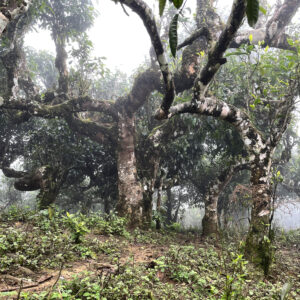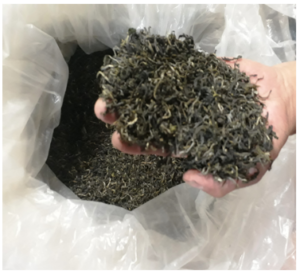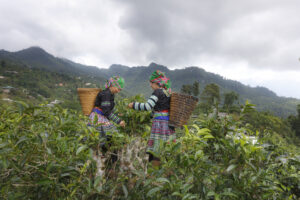
In the northernmost part of Vietnam, there is an area nestled among forests between 600 and 1,600 meters above sea level called Hà Giang. It is near the border of Yunnan, China, and blessed with the Shan Tuyết Tea trees, some of which are hundreds of years old. In fact, there are 220 ancient trees that represent the area of Cao Bo, Hà Giang Province. These trees protect the gene pool of the famous tea originating in these mountains.
“Tuyết” means snow. Locals believe that the Shan Tuyết tea does not need much care, fertilizers, or pesticides as it is flavored by natural mist and fog all year round.
The Shan Tuyết tea has been a part of the heritage of the Dao and H’Mong tribes residing in the region. The unique flavor of the tea is attained by it being exposed to the mist, and this mist is crystallized snow from the mountains.
The Hà Giang region’s terrain, comprised of mountains measuring 600 meters and above, with an inclination of 8 – 30 degrees, presents a highly complex terrain structure. Specifically, the medium-high mountains over 1,000 meters upstream of the Chảy River are composed of granite, while lower mountain terrains of 600 – 1,000 meters are formed mostly by magma rock, sedimentary rock, and metamorphic rock. The cultivation area of the Shan Tuyết Tea resides in the humid tropical climate, under the influence of the monsoons.
Geographical Indication: A Milestone for Hà Giang Shan Tuyết Tea

In 2017, the National Office of Intellectual Property of Viet Nam accorded Geographical Indication (GI) status to the “Hà Giang” Shan Tuyết Tea. GIs designate and protect products whose quality, reputation, and characteristics are intrinsically tied to their specific geographical location. The Department of Agriculture and Rural Development of Hà Giang Province is the organization in charge of managing and administering this GI.
The GI status has several crucial implications:
- Protection of Authenticity and Quality: The GI ensures that only tea produced in the designated region and meeting the specified standards can be marketed as “Hà Giang” Shan Tuyết Tea.
- Market Differentiation: In a very competitive market for tea, the GI enables tourists and consumers to recognize the Hà Giang tea and distinguish it from other teas that do not possess the same qualities and characteristics.
- Economic Benefits to Local Producers: the GI leverages its unique regional characteristics to attract consumers who value authenticity and are willing to pay a higher price for high-quality tea. Economic benefits derived from the premium pricing of Hà Giang Tea remain with the local community.
- Promotion of Cultural Heritage: Traditional methods of tea cultivation and processing, embodied in the Book of Specifications of the registered GI, preserve the cultural identity and heritage of the local communities, enhancing the experience of tourists interested in the rich tradition and history of Hà Giang Tea.
Tourism and Economic Growth: A Regional Transformation

Hà Giang Shan Tuyết Tea was not known until researchers and tourists from within and outside of the country came to this rural mountainous province and discovered this high-quality beverage. Owing to its unique and enchanting geography, Hà Giang has been a popular destination for bikers, hikers, and other tourists. They commenced bringing the tea back to the cities and realized that it was extremely well received by consumers. Today, the GI label “HÀ GIANG SHAN TUYẾT TEA” is a quality guarantee for tourists and shoppers, who can be sure they are getting real and authentic “Tuyết” tea.
Here, tourists explore the Hà Giang loop trail, numerous walking tours, and homestay accommodations where guests can help on the farm for four hours a day, five days a week, in exchange for accommodation and food. In 2022, 2.2 million tourists visited Hà Giang, bringing revenues of 4,306 billion VND. In fact, tourism brings 4.29 times more income than agricultural products alone. The average tourist growth rate is more than 15%, creating 12,000 jobs and 6000 direct jobs in Hà Giang region.
Despite the COVID-19 pandemic and challenging access to this region, Hà Giang welcomed 1.5 million visitors in 2020, an increase of 7% from 2019. While there were only 183 guesthouses or accommodations in 2016, the number rose to 882 by 2020, ranging from one to three-star hotels and guesthouses. The most significant increase, however, is found in the category of homestays: from none in 2016 to 509 in 2022.
The Allure of Shan Tuyết Tea: Flavor and Tradition
Hà Giang Shan Tuyết tea possesses a distinctive appearance and quality, easily noticeable from its consistent color and size. The buds are young and rough, tightly twisted, silver (snow)-tipped, and the leaves are big and round. When brewed, the tea is shiny with a distinctive eye-catching yellowish-green colour, natural aroma, a light bitter taste, and a sweet aftertaste—a perfect combination of taste, aroma, and purity.

As mentioned, these qualities result from the Hà Giang region’s unique natural characteristics: the cool climate, the fog and mist covering the tea all year round, etc., and the completely organic cultivation practice of the local farmers.
In addition to the traditional cultivation process, Hà Giang locals consider that the Shan Tuyết Tea does not require tending. It takes the mist of the nights and the sunlight of the early mornings to grow, and its leaves are green throughout four seasons. Farmers employ manual methods to prevent pests and diseases or make biological pesticides from lime and pomelo skin, garlic, pepper, etc. In Hà Giang, the farmers also keep the special long-held tradition of not cultivating the tea on these three days in the lunar calendar: Day of the Thunder God (March 1st), Day of the Wind God (January 20th), and Day of the Wild Boars (March 3rd).
Hà Giang Shan Tuyết Tea is more than just a beverage—it is a living testament to the region’s natural wealth, cultural heritage, and sustainable practices.
With its GI status ensuring authenticity and premium quality, the tea has become a cornerstone of Hà Giang’s economic and tourism growth. As the region continues to welcome more visitors and global recognition, Hà Giang Shan Tuyết Tea stands poised to preserve its legacy while creating new opportunities for the local community.






